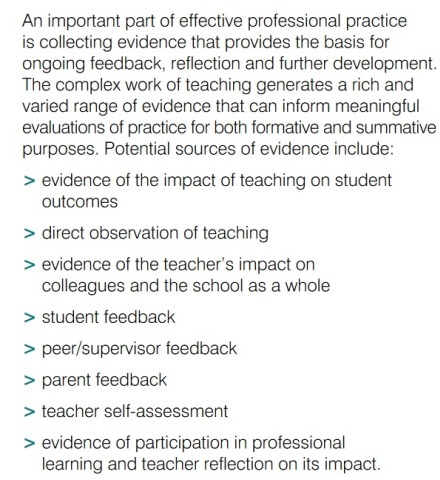In the last decade the discussion of ‘teacher quality' has dominated much of the political and ideological debate about education nationally and internationally.
At the same time, schools and school leaders have focused significant resources on improving the quality of ‘teaching and learning practice'.
At the heart of this debate is a very complex question of whether policy makers want to try to improve people (teachers and students) or improve practice (teaching and learning).
In publishing the Australian Professional Standards for Teachers (APST), the Australian Institute for Teaching and School Leadership (AITSL) identified eight methods of assessment that would be used. One of these was direct observation of teaching and three related to direct feedback on teaching practice (see Figure 1 below).

[Figure 1: Australian Teacher Performance and Development Framework, August 2012].
In this context, the responsibility of schools is to ensure high quality assessment of classroom practice as part of accreditation and registration as well as developing a growing understanding of the use of classroom observation and feedback as key tools for improving the quality of teaching and learning practice for individual teachers, teams and schools.
The context of our work
As part of a series of professional learning programs for classroom observers delivered to just over 200 principals and senior supervisors in secondary schools in New South Wales during 2015 and 2016, we asked participants how many of them had observed a class in the last 12 months. All of them had. We then asked how many of them had had professional learning and/or training as an observer. Less than 10 had had any formal training and only 10 per cent had received training that involved watching a teacher with a class.
We noted how often schools and systems assumed that any teacher in a supervisory position would know how to observe a class and give constructive feedback aimed at improvement. We noted that few observers questioned their own consistency between classes and teachers and that few schools had processes in place for observers to work together to design protocols for observation and feedback.
Some schools used well researched observational tools (Danielson, 2011), others tried to make judgements against the APST, and others left the decision to an individual supervisor. We noted that few supervisors had ever been asked to consider the reliability and validity of the school's observations – whether these were of undergraduates by academic observers or of more experienced and expert teachers by more experienced and expert teachers. We also noted that many teachers ‘stuck to the script' when being observed and that observers were often more comfortable commenting on classroom management than learning behaviours and instruction.
From the professional work of the school teams with whom we worked, five key questions emerged that we think require further investigation.
Five key questions on classroom observation
- What professional learning do supervisors and school teams need to improve practice in student, self, peer and supervisor observation in the school?
- How do observers address their own biases and build the consistency of observer judgement across the school?
- How do we encourage teachers to ‘leave the script' and be more adaptive, while at the same time building their capacity in learning/lesson design?
- How does each school create adaptive protocols based on a shared understanding of the culture and learning context of classroom practice in the school?
- How does teacher performance assessment measure the impact of teachers and teams on the whole teaching/learning cycle including lesson design?
We will address the first two of these questions, leaving the remaining three for a subsequent article.
Our thoughts on questions 1 and 2
We think the first and compulsory step here is to orientate classroom observation in your school as a practical improvement measure with clear links to teacher professional learning.
The shorter the feedback loop between the observation and the ensuing professional learning the better chance it has of being accepted by your team as an improvement measure. Valid classroom observation guides have indicators that can be made explicit via video, demonstration or explanation.
The next step in professional learning is to have your team agree to a set of protocols for use of the observation guides. Consensus needs to be reached on the focus of the observation (teacher, students or both), the frequency and duration of observations, the structure of pre- and post-observation meetings, who is going to own and control these data (critical with video recordings), and last, but certainly not least, the classroom observation guide to be used. We suggest that any classroom observation guide used needs to have cross-referenced links to the APST for accreditation purposes.
In our own experience, it is an achievement to reach a majority consensus on all of the above issues in a school. The next challenge then is to ensure that the observers are consistent in their judgments over time (intra-rater reliability) and that these judgements are consistent with other observers looking at the same classroom (inter-rater reliability).
Validated classroom observation instruments such as Class-S out of the University of Virginia (Stuhlman, Hamre, Downer, & Pianta, 2014) devote many resources to ensuring that the observers who use their instrument are using it reliably. Observers have to pass an initial certified training course and also undergo bi-annual recertification where their rating scores on online classroom videos have to fall within what is regarded as an acceptable margin of error. These certification practices may not be within the reach of your own small scale (and smaller or non-existent budget) classroom observation endeavour, but it does draw our attention to two salient issues regarding reliability in classroom observations.
First, it is much easier to measure rater reliability if you are using scores. Second, time spent on training observers is time well spent. This last point is pertinent given the fact that we found that only 10 per cent of participants in our course had any training of any sort in classroom observation.
In 2014 Christine Cawsey, Tony Loughland and Peter Langfield designed and in 2015-2016 delivered a professional learning program at the Lead Level of the Australian Professional Standards for Teachers – Leading and Improving Classroom Observation: Classroom Observation as Professional Learning.
Stay tuned: The authors will address the final three questions in a future Teacher article.
References
Danielson, C. (2011) The Framework for Teaching Evaluation Instrument 2011 edition. Retrieved 29/5/14 from http://tpep.wa.org/wp-content/uploads/the-framework-for-teaching-evaluation-instrument-2011.pdf
Stuhlman, M., Hamre, B., Downer, J., & Pianta, R. C. (2014). How Classroom Observations Can Support Systematic Improvement in Teacher Effectiveness. Retrieved from http://curry.virginia.edu/uploads/resourceLibrary/CASTL_practioner_Part5_single.pdf
As a school leader, what are the professional learning needs of your staff in relation to classroom observation? How many members of staff have received formal training in this area?
As an observer, how often do you reflect on the consistency of your judgements?
The authors say ‘the shorter the feedback loop between the observation and the ensuing professional learning the better…’. Think about the process in your own school – how could you make the feedback loop shorter?



